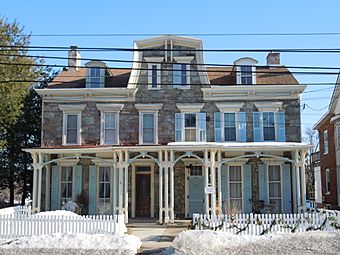East Lancaster Avenue Historic District facts for kids
Quick facts for kids |
|
|
East Lancaster Avenue Historic District
|
|

Hunt-Downing House (c. 1802) in the East Lancaster Avenue Historic District, February 2011
|
|
| Location | An irregular pattern along E. Lancaster Ave., Downingtown, Pennsylvania |
|---|---|
| Area | 51.3 acres (20.8 ha) |
| Built | 1700 |
| Architectural style | Late Victorian, Georgian, Federal |
| NRHP reference No. | 79002196 |
| Added to NRHP | December 11, 1979 |
The East Lancaster Avenue Historic District is a special area in Downingtown, Pennsylvania. It's like a living museum, showing how buildings looked long ago. This district is recognized as a national historic place.
It includes 121 important buildings and one structure. These buildings show different styles of architecture from the past. You can see homes built in the 1700s and later. Two very famous buildings here are the Downingtown Log House and the General Washington Inn. This district was added to the National Register of Historic Places in 1979. This means it's officially important to American history.
Exploring the East Lancaster Avenue Historic District
Imagine walking through a neighborhood where every building tells a story. That's what it's like in the East Lancaster Avenue Historic District. This area covers about 51 acres. It's a great place to learn about how people lived and built homes centuries ago.
What is a Historic District?
A historic district is a special area with many old buildings. These buildings are important because of their history or how they were built. They show us what life was like in the past. Protecting these areas helps us remember our history. It also helps future generations learn from the past.
A Walk Through Time: Building Styles
The buildings in this district show different popular styles from history. You can see how building designs changed over time. The main styles here are Georgian, Federal, and Victorian. Each style has its own unique look.
Georgian Style: Simple and Grand
Many of the oldest homes here are in the Georgian style. This style was popular in the 1700s. Georgian buildings often look very balanced and symmetrical. They usually have a main door in the center. Windows are often evenly spaced on both sides. These homes often feel grand but also simple.
Federal Style: Elegant and Balanced
After the Georgian style came the Federal style. This was popular in the late 1700s and early 1800s. Federal style buildings are also balanced. However, they often have more delicate details. You might see fanlights above doors or decorative trim. They often feel more elegant and refined than Georgian homes.
Victorian Style: Ornate and Detailed
Later, in the 1800s, the Victorian style became popular. These homes are very different from the earlier styles. Victorian buildings are known for being very ornate. They often have lots of decorative elements. You might see towers, turrets, or fancy porches. Each Victorian home can look very unique.
Famous Buildings in the District
Within the East Lancaster Avenue Historic District, some buildings stand out. They are especially important for their history or architecture.
The Downingtown Log House
The Downingtown Log House is one of the oldest buildings in the district. It's a great example of early American construction. Log houses were common when settlers first arrived. This house shows how people built homes with the materials they had. It gives us a peek into very early life in Pennsylvania.
The General Washington Inn
The General Washington Inn is another key building. Inns were important places in the past. Travelers would stop there to rest and eat. This inn likely hosted many people over the centuries. It reminds us of the days when travel was much slower. It also shows how communities grew around places like inns.
Why is This Place Important?
The East Lancaster Avenue Historic District is important for many reasons. It helps us understand the history of Downingtown. It also shows how architecture changed over centuries. By protecting these buildings, we save a piece of our past. It allows us to learn about the people who lived here long ago. It's a valuable place for education and preserving history.



